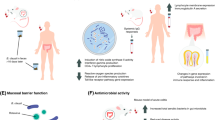Abstract
The establishment and proliferation of a model population of autochthonous surface-associated microorganisms in the small bowel of growing rats (2–12 weeks of age) was studied. Segmented filamentous bacteria on the distal ileal villi were examined by scanning electron microscopy (SEM) and countedin situ by transect line analysis. In young animals, these bacteria first colonized the villous base, but occupied all areas on the villus by adult age. Their distribution on Peyer's patches was also noted.
In growing animals, colonization of the ileal villi by filamentous bacteria was significantly correlated to the development of host resistance to fatal infection by orally-dosedSalmonella enteritidis. In animals givenSalmonella and examined by SEM and transmission EM (TEM), the pathogen was seen only on ileal tissue surfaces, predominantly the villous base, from which the autochthonous population was absent. Conversely, in animals with filamentous bacteria,Salmonella surface colonization was not observed. The results suggest a possible protective role for the surface flora in the small bowel.
Similar content being viewed by others
References
Abrams GD, Bishop JE (1966) Effect of normal microbial flora on the resistance of the small intestine to infection. J Bacteriol 92:1604–1608
Abrams GD (1977) Microbial effects on mucosal structure and function. Am J Clin Nutr 30:1880–1886
Bracke JW, Cruden D Loeb, Markovetz AJ (1979) Intestinal microbial flora of the American cockroach,Periplaneta americana L. Appl Environ Microbiol 38:945–955
Brooker BE, Fuller R (1975) Adhesion of lactobacilli to the chicken crop epithelium. J Ultrastruct Res 52:21–31
Carter PB, Collins FM (1974) The route of enteric infection in normal mice. J Exp Med 139:1189–1203
Chase DG, Erlandsen SL (1976) Evidence for a complex life cycle and endospore formation in the attached, filamentous, segmented bacteria from murine ileum. J Bacteriol 127:572–583
Cheng K-J, McCowan RP, Costerton JW (1979) Adherent epithelial bacteria in ruminants and their roles in digestive tract function. Am J Clin Nutr 32:139–148
Collins FM (1974) Vaccines and cell-mediated immunity. Bacteriol Rev 38:371–402
Davis CP, Savage DC (1974) Habitat, succession, attachment and morphology of segmented, filamentous microbes indigenous to the murine gastrointestinal tract. Infect Immun 10:948–956
Dubos RJ, Schaedler RW, Costello R, Hoet P (1965) Indigenous, normal and autochthonous flora of the gastrointestinal tract. J Exp Med 122:67–76
Fahey KJ, Cooper GN (1970) Oral immunization in experimental salmonellosis. II. Characteristics of the immune response to temperature-sensitive mutants given by oral and parenteral routes. Infect Immun 2:183–191
Garland CD, Stark AE, Lee A, Dickson MR (1978) Quantitation of autochthonous bacteria in rat ileum by scanning electron microscopy and transect line analysis. In: Loutit MW, and Miles JAR (eds) Microbial Ecology. Springer-Berlin, pp 240–243
Garland CD, Lee A, Dickson MR (1979) The preservation of surface-associated microorganisms prepared for scanning electron microscopy. J Microsc 116:227–242
Hohmann AW, Schmidt G, Rowley D (1978) Intestinal colonization and virulence ofSalmonella in mice. Infect. Immun. 22:763–770
Lee A, Gemmell E (1972) Changes in the mouse intestinal microflora during weaning: role of volatile fatty acids. Infect Immun 5:1–7
Lee A (1980) Normal flora of animal intestinal surfaces. In: Bitton G, and Marshall KC (eds). Adsorption of Microorganisms to Surfaces. Wiley, New York, pp 145–173
Meynell, GG (1963) Antibacterial mechanisms of the mouse gut. II. The role of Eh and volatile fatty acids in the normal gut. Br J Exp Pathol 44:209–219
Owen RL, Nemanic P (1978) Antigen processing structures of the mammalian intestinal tract: an SEM study of lymphoepithelial organs. Scanning Electron Microscopy/1978/II, SEM Inc, AMF O'Hare, pp 367–378
Porvaznik M, Walker RI, Gillmore JD (1979) Reduction of the indigenous filamentous microorganisms in rat ilea followingγ-radiation. Scanning Electron Microscopy/1979/III, SEM Inc, AMF O'Hare, pp 15–21
Savage DC (1969) Localization of certain indigenous microorganisms on the ileal villi of rats. J Bacteriol 97:1505–1506
Savage DC (1977) Microbial ecology of the gastro-intestinal tract. Annu Rev Microbiol 31:107–133
Tannock GW, Savage DC (1974) Influences of dietary and environmental stress on microbial populations in the murine gastrointestinal tract. Infect Immun 9:591–598
Tannock GW, Blumershine RVH, Savage DC (1975) Association ofSalmonella typhimurium with, and its invasion of, the ileal mucosa in mice. Infect Immun 11:365–370
Author information
Authors and Affiliations
Rights and permissions
About this article
Cite this article
Garland, C.D., Lee, A. & Dickson, M.R. Segmented filamentous bacteria in the rodent small intestine: Their colonization of growing animals and possible role in host resistance toSalmonella . Microb Ecol 8, 181–190 (1982). https://doi.org/10.1007/BF02010451
Issue Date:
DOI: https://doi.org/10.1007/BF02010451




